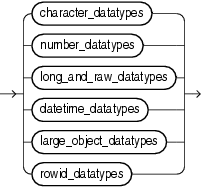SQL Datatypes
- A data type defines a sort of value that a column should contain.
- In a database table, every column is necessary to have a name and data type.
- Data type may vary depending on the database.
- A datatype associates a fixed set of properties with the values that can be used in a column of a table or in an argument of a procedure or function.
- These properties cause Oracle to treat values of one datatype differently from values of another datatype;
- For example, Oracle can add values of NUMBER datatype but not values of RAW datatype.
- Oracle supplies the following built-in datatypes:
- Character datatypes
- CHAR
- CHAR (size)
- Fixed-length character data of length size bytes.
- Fixed for every row in the table (with trailing blanks); maximum size is 2000 bytes per row, the default size is 1 byte per row. Consider the character set (one-byte or multibyte) before setting size.
- NCHAR
- NCHAR(size)
- Fixed-length character data of length size characters or bytes, depending on the national character set.
- Fixed for every row in the table (with trailing blanks). Column size is the number of characters for a fixed-width national character set or the number of bytes for a varying-width national character set. Maximum size is determined by the number of bytes required to store one character, with an upper limit of 2000 bytes per row. Default is 1 character or 1 byte, depending on the character set.
- VARCHAR2 and VARCHAR
- VARCHAR2 (size)
- Variable-length character data.
- Variable for each row, up to 4000 bytes per row. Consider the character set (one-byte or multibyte) before setting size. A maximum size must be specified.
- NVARCHAR2
- NVARCHAR2 (size)
- Variable-length character data of length size characters or bytes, depending on national character set. A maximum size must be specified.
- Variable for each row. Column size is the number of characters for a fixed-width national character set or the number of bytes for a varying-width national character set. Maximum size is determined by the number of bytes required to store one character, with an upper limit of 4000 bytes per row. Default is 1 character or 1 byte, depending on the character set.
- CLOB
- Single-byte character data.
- Up to 2^32 - 1 bytes, or 4 gigabytes.
- NCLOB
- Single-byte or fixed-length multibyte national character set (NCHAR) data.
- Up to 2^32 - 1 bytes, or 4 gigabytes.
- LONG
- LONG
- Variable-length character data.
- Variable for each row in the table, up to 2^31 - 1 bytes, or 2 gigabytes, per row. Provided for backward compatibility.
- NUMBER datatype
- NUMBER (p, s)
- Variable-length numeric data. Maximum precision p and/or scale s is 38.
- Variable for each row. The maximum space required for a given column is 21 bytes per row.
- DATE datatype
- Fixed-length date and time data, ranging from Jan. 1, 4712 B.C.E. to Dec. 31, 4712 C.E.
- Fixed at 7 bytes for each row in the table.
- The default format is a string (such as DD-MON-YY).
- Binary data types
- ROWID
- Binary data representing row addresses.
- Fixed at 10 bytes (extended ROWID) or 6 bytes (restricted ROWID) for each row in the table.
- BLOB
- Unstructured binary data.
- Up to 2^32 - 1 bytes, or 4 gigabytes.
- BFILE
- Binary data stored in an external file.
- Up to 2^32 - 1 bytes, or 4 gigabytes.
- RAW
- RAW (size)
- Variable-length raw binary data.
- Variable for each row in the table, up to 2000 bytes per row. A maximum size must be specified. Provided for backward compatibility.
- LONG RAW
- Variable-length raw binary data.
- Variable for each row in the table, up to 2^31 - 1 bytes, or 2 gigabytes, per row. Provided for backward compatibility.
Tags:
DBMS

